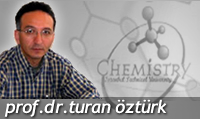

|
News & Events
Contact Us Phone: +90 (212) 285 6994 |
Prof.Dr.Turan Öztürk 
Turan Öztürk was born in Kizilcaören, a small village in Divrigi area in
east central Anatolia, Turkey. He received his B.Sc. and M.Sc. degrees
from Middle East Technical and Istanbul Technical Universities,
respectively.
He completed his Ph.D. study at the University of East Anglia as a Turkish Government scholarship holder under the supervision of Professor A. McKillop on the synthesis of amphimedine alkaloid in 1990. He was then moved to the University of Kent at Canterbury to join Dr. John D. Wallis’ group as a postdoctoral fellow (1991 – 1994), financed by SERC Molecular Electronics Committee and 21st Century Material Initiative, and visiting research fellow (1995), where he worked on the synthesis of new bis(etylenedithio)tetrathiafulvalene (BEDT-TTF) type organic superconductors and developed a new method for the synthesis of fused 1,4-dithiin and thiophene rings from 1,8-diketones using Lawesson’s Reagent and P4S10.
Sept. 2003- Professor, Istanbul Technical University, Art and
Science Faculty, Chemistry Department, Organic Chemistry, Istanbul,
Turkey
April-2003-Sept. 2003 Lecturer, Middle East Technical University, Art and Science Faculty, Chemistry Department, Organic Chemistry, Ankara, Turkey April 1996-June 2002 Head of Organic Technologies Division, Scientific and Technical Research Council of Turkey-Marmara Research Centre, Chemistry Department, Gebze-Kocali, Turkey During my employment at Marmara Research Centre, I directed a PhD and two MSc studies. The PhD study and one of the MSc studies were on the synthesis of new BEDT-TTF analogues, employing 1,8-diketone ring closure reaction, and the other MSc study was, in cooperation with Kiev Shevcheuko University, Ukraine, on “Design and Synthesis of New Florescence Probes based on 3-Hydroxyflavones”. My other duties involved various analyses and industries’ problem-solving, particularly pharmaceutical industries. April 1994- March 1996 Visiting Research Fellow, University of Kent at Canterbury,Chemical Laboratory, Canterbury Kent CT2 7NH, England. During the course of my visiting research fellowship, I wrote a chapter for The Alkaloids entitled “Alkaloids Containing Quinolinequinone and Quinolinequinoneimine Units”, The Alkaloids, Ed. Cordell, Academic Press, San Diego, 1997, Vol. 49, Chapter 2, page 79-219. (A second chapter entitled “Alkaloids Containing An Isoquinolinequinone Unit” for the same series has been published recently, The Alkaloids, Ed. Cordell, Academic Presss, San Diego, 2000, 119-238). I also carried out my own projects. One of them resulted in the development of a new reaction of Lawesson’s Reagent with 1,8-diketones, Tetrahedron Lett. 1996, 37, 2821. During the postdoctoral posts, I gave assistance to the PhD students and supervised undergraduate project students. April 1991- April 1994 Research Fellow with Dr J. D. Wallis, University of Kent atCanterbury Chemical Laboratory, Canterbury, Kent CT2 7NH, England Title of the Study: "The Synthesis and Properties of New Organic Superconductors". Financial Source: The SERC Molecular Electronics Committee and 21st Century Materials Initiative, England. The purpose of the study was to develop new crystalline organic substances which superconduct at significantly higher temperatures than the currently known organic superconductors (i.e.>12.8 K). The best materials to date are radical cation salts of bis(ethylenedithio)tetrathiafulvalene ('BEDT-TTF' or 'ET'). The aim of the research was to make derivatives of ET (or similar heterocyclic systems) with functional groups on ethylene bridges which can hydrogen bond or make other attractive interactions with the anions in the salt. Important parts of the study involved the introduction of the desired chirality on the ethylene bridges, and either self or cross-coupling of the asymmetric ketones or thiones. 1984-1986 Research Assistant, Demonstrator, Istanbul Technical University, Chemistry Dep. Organic Chemistry, Maslak Istanbul, Turkey |